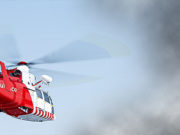
Despite year-over-year increases in accidents and fatal accidents in 2018, the commercial airline industry continued a long-term trend toward accident reduction, the International Air Transport Association (IATA) says.1
Sixty-two commercial airline accidents were recorded in 2018, including 11 fatal accidents that resulted in 523 on-board fatalities, according to the IATA data, released in February. Those numbers compare with 46 total accidents, six fatal accidents and a record-low 19 on-board fatalities in 2017 (Table 1). One 2017 accident also killed 35 people on the ground.
The total accident rate for the year was 1.35 accidents per 1 million flights — the equivalent of one accident every 740,000 flights, according to IATA data released in February (Figure 1). The number reflected a decline in safety from the 2017 record low rate of 1.11 accidents per million flights but an improvement over the all-accident rate of 1.79 per million flights for the five-year period from 2013 through 2017.
| 2013 | 2014 | 2015 | 2016 | 2017 | 2018 | Average 2013–2017 |
|
|---|---|---|---|---|---|---|---|
|
* Flight information provided by Ascend FlightGlobal. ** Fatality figures provided by Ascend FlightGlobal. Source: International Air Transport Association |
|||||||
| Yearly flights (millions)* | 36.3 | 36.5 | 36.9 | 39.0 | 41.3 | 46.1 | 38.0 |
| Total accidents | 86 | 77 | 67 | 64 | 46 | 62 | 68.0 |
| Fatal accidents | 14 | 12 | 4 | 8 | 6 | 11 | 8.8 |
| Fatalities** | 178 | 641 | 136 | 198 | 19 | 523 | 234.4 |
Figure 1 — All Accident Rate, 2013–2018
Source: International Air Transport Association
IATA Director General and CEO Alexandre de Juniac noted that 4.3 billion passengers were flown on 46.1 million flights in 2018 but added, “2018 was not the extraordinary year that 2017 was. However, flying is safe, and the data tell us that it is getting safer. For example, if safety in 2018 had remained at the same level as 2013, there would have been 109 accidents instead of 62 and there would have been 18 fatal accidents instead of the 11 that actually occurred.”
The data show that, on average, a passenger could take one flight every day for 241 years before being on a flight that was involved in an accident resulting in one fatality, de Juniac said.
The industry recorded 0.19 major jet accidents (which IATA measures as the number of jet hull losses2 per million flights) per million flights in 2018; the equivalent is one major accident for every 5.4 million flights. In comparison, the 2017 rate was 0.12 per million flights, and the 2013–2017 rate was 0.29 per million.
A regional breakdown of jet hull losses showed that four regions recorded no hull losses in 2018 — Africa, Europe, Middle East and North Africa, and North Asia. The highest hull loss rate was the 1.19 per million flight sectors recorded in the Commonwealth of Independent States (Table 2).
| 2013 | 2014 | 2015 | 2016 | 2017 | 2018 | Average 2013–2017 |
|
|---|---|---|---|---|---|---|---|
|
Source: International Air Transport Association |
|||||||
| Africa | 0.00 | 1.78 | 3.53 | 0.00 | 0.00 | 0.00 | 1.06 |
| Asia Pacific | 0.70 | 0.44 | 0.21 | 0.39 | 0.18 | 0.32 | 0.37 |
| Commonwealth of Independent States | 1.22 | 0.91 | 1.92 | 0.00 | 0.89 | 1.19 | 1.00 |
| Europe | 0.00 | 0.15 | 0.15 | 0.28 | 0.13 | 0.00 | 0.14 |
| Latin America and the Caribbean | 0.45 | 0.43 | 0.41 | 0.81 | 0.41 | 0.76 | 0.51 |
| Middle East and North Africa | 1.33 | 0.64 | 0.00 | 1.72 | 0.00 | 0.00 | 0.72 |
| North America | 0.33 | 0.11 | 0.34 | 0.33 | 0.00 | 0.10 | 0.22 |
| North Asia | 0.00 | 0.00 | 0.00 | 0.00 | 0.00 | 0.00 | 0.00 |
| Industry | 0.37 | 0.27 | 0.33 | 0.37 | 0.12 | 0.19 | 0.29 |
| IATA Member Airlines | 0.31 | 0.00 | 0.22 | 0.31 | 0.00 | 0.09 | 0.16 |
The turboprop hull loss rate in 2018 was 0.60 per million flight sectors, about half the 2017 rate of 1.23 per million sectors and about one-third the 2013–2017 rate of 1.83 per million sectors, the report said.
A regional breakdown showed that no turboprop hull loses were recorded in four regions — Europe, Latin America and the Caribbean, North America, and North Asia. The highest rates were 7.48 per million flight sectors, recorded in the Commonwealth of Independent States, and 5.86, recorded in the Middle East and North Africa.
IATA also compared the total accident rates of carriers that had passed an IATA Operational Safety Audit (IOSA), an internationally accepted evaluation system that examines airlines’ operational management and control systems. For 2018, with the total accident rate of 1.35 per million flight sectors, the rate for operators on the IOSA Registry was 0.98 accidents per million flight sectors, compared with 2.16 per million sectors for operators not on the IOSA Registry (Table 3).
| 2013 | 2014 | 2015 | 2016 | 2017 | 2018 | Average 2013–2017 |
|
|---|---|---|---|---|---|---|---|
|
IATA = International Air Transport Association; IOSA = IATA Operational Safety Audit Source: International Air Transport Association |
|||||||
| Industry | 2.37 | 2.11 | 1.81 | 1.64 | 1.11 | 1.35 | 1.79 |
| IOSA | 1.67 | 1.08 | 1.32 | 1.36 | 0.56 | 0.98 | 1.18 |
| Non-IOSA | 3.63 | 4.12 | 2.84 | 2.25 | 2.31 | 2.16 | 3.03 |
Note
- IATA defines an accident as “an event in which all of the following criteria are satisfied:
- “Person(s) have boarded the aircraft with the intention of flight (either flight crew or passengers.
- “The intention of the flight is limited to normal commercial aviation activities, specifically scheduled/charter passenger or cargo service. Executive jet operations, training, maintenance/test flights are all excluded.
- “The aircraft is turbine powered and has a certificated maximum takeoff weight … of at least 5,700 kg (12,540 lb).
- “The aircraft has sustained major structural damage exceeding $1 million or 10 percent of the aircraft’s hull reserve value, whichever is lower, or has been declared a hull loss.”
- IATA defined a hull loss as “an accident in which the aircraft is destroyed or substantially damaged and is not subsequently repaired for whatever reason, including a financial decision of the owner.”


